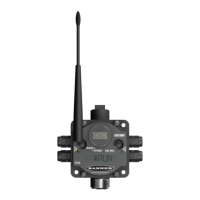R (red) = poor signal strength
M = Missed packet
To disable Site Survey, send control code 32 (0x20) and Node number 0 (0x0), which is represented as 8192 (0x2000).
3.6.3 Site Survey Data Holding
With Site Survey active, registers I/O 7 and 8 are Site Survey data holding registers that store the accumulated Site Survey
results. Error collections in holding register 8 are saved when Site Survey runs and restored after Site Survey is disabled.
Register
[15:8] [7:0]
I/O 7 Red Total Missed Total
I/O 8 Green Total Yellow Total
Example Results
[15:8] [7:0]
I/O 7 10 0
I/O 8 80 10
Note: This is the current register arrangement when using Modbus/TCP or Modbus RTU. In some older
models, the Modbus/TCP registers are reversed (missed and yellow totals are in [8:15], red and green
totals are in [0:7]).
3.6.4 Interpreting the Site Survey Results
Site Survey results are listed as a percentage of data packets received and indicate the signal strength of the received
signal.
Result Description
Green
Packets received at a strong signal strength. A strong signal strength is greater than −90
dBm at the receiver.
Yellow
Packets received at a good signal strength. A good signal is between −90 and −100 dBm
at the receiver.
Red
Packets received at a weak signal strength. A weak signal is less than −100 dBm at the
receiver.
Missed Packets not received on the first transmission and requiring a retry.
Judging if the reliability of a network’s signal meets the needs of the application is not just a matter of green, yellow, and red
packets received. In normal operating mode, when data packets are not received, the transmitter re-sends the packet until
all data is received.
For slow monitoring applications such as a tank farm, where data is required in terms of seconds or minutes, receiving most
of the data in the ‘red’ range, indicating a weak but reliable signal, transmits enough data for accurate monitoring. Nodes
positioned near the outside range of the radio signal may have 90% of the data packets received in the red zone, again
indicating a weak, but reliable signal.
We recommend keeping the missed packets average to less than 25%. When the network misses more than 25% of the
data packets, the signal is usually too unreliable or obstacles may be interfering with the signal. When Site Survey reports
the missed packets are 25% or higher, improve the radio system performance by:
• Mounting the network’s antennas higher to clear obstacles in the area and improve the line of sight between Sure
Cross
®
devices
• Using higher gain antennas to focus the energy of the radio signal in a
specific direction and extend the signal’s
range
• Adding data radios to the network to extend the range of a radio network. For more information on data radios,
please refer to Banner’s white paper on range extension on
www.bannerengineering.com/wireless
.
Sure Cross
®
Performance DX80 Wireless I/O Networks
www.bannerengineering.com - Tel: + 1 888 373 6767 19

